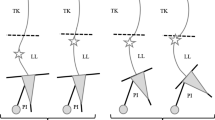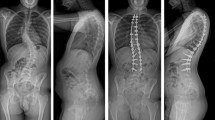Abstract
Study design
This is a retrospective, single-institution, cohort study.
Objectives
To evaluate the association of Mersilene tape use and risk of proximal junctional kyphosis (PJK), after surgical correction of adult spinal deformity (ASD) by posterior instrumented fusion (PIF).
Summary of background data
PJK, following long spinal PIF, is a complication which often requires reoperation. Mersilene tape, strap stabilization of the supra-adjacent level to upper instrumented vertebra (UIV) seems a preventive measure.
Methods
Patients who underwent PIF for ASD with Mersilene tape stabilization (case group) or without (control group) between 2006 and 2016 were analyzed preoperatively to 2-year follow-up. Matching of potential controls to each case was performed. Radiographic sagittal Cobb angle (SCA), lumbar lordosis, pelvic tilt, sacral slope, and pelvic incidence were measured pre- and postoperatively, using a deformity measuring software program. PJK was defined as progression of postoperative junctional SCA at UIV ≥ 10°.
Results
Eighty patients were included: 20 cases and 60 controls. The cumulative rate of PJK ≥ 10° at 2-year follow-up was 15% in cases versus 38% of controls (OR = 0.28; P = 0.04) with higher latent period in cases, (20 vs. 7.5 months), P = 0.018. Mersilene tape decreased risk of PJK linked with the impact of the following confounders: age, ≥ 55 years old (OR = 0.19; 0.02 ≥ P ≤ 0.03); number of spinal levels fused 7–15 (OR = 0.13; 0.02 ≥ P ≤ 0.06); thoracic UIV (T12–T1) (OR = 0.13; 0.02 ≥ P ≤ 0.06); BMI ≥ 27 kg/m2 (OR = 0.22; 0.03 ≥ P ≤ 0.08); and osteoporosis (OR = 0.13; 0.02 ≥ P ≤ 0.08).
Conclusions
Mersilene tape at UIV + 1 level decreases the risk of PJK following PIF for ASD.
Graphic abstract
These slides can be retrieved under Electronic Supplementary Material.





Similar content being viewed by others
References
Hostin R, McCarthy I, O’Brien M et al (2013) Incidence, mode, and location of acute proximal junctional failures after surgical treatment of adult spinal deformity. Spine (Phila Pa 1976) 38(12):1008–1015
Maruo K, Ha Y, Inoue S et al (2013) Predictive factors for proximal junctional kyphosis in long fusions to the sacrum in adult spinal deformity. Spine (Phila Pa 1976) 38(23):E1469–E1476
Yagi M, King A, Boachie-Adjei O (2012) Incidence, risk factors, and natural course of proximal junctional kyphosis: surgical outcomes review of adult idiopathic scoliosis. Minimum 5 years of follow-up. Spine (Phila Pa 1976) 37(17):1479–1489
Javedan SP, Dickman CA (1999) Cause of adjacent-segment disease after spinal fusion. Lancet (London, England) 354(9178):530–531
Kim YJ, Bridwell KH, Lenke LG et al (2008) Proximal junctional kyphosis in adult spinal deformity after segmental posterior spinal instrumentation and fusion: minimum five-year follow-up. Spine (Phila Pa 1976) 33(20):2179–2184
Nguyen NL, Kong CY, Hart RA (2016) Proximal junctional kyphosis and failure-diagnosis, prevention, and treatment. Curr Rev Musculoskelet Med 9(3):299–308
Lau D, Clark AJ, Scheer JK et al (2014) Proximal junctional kyphosis and failure after spinal deformity surgery: a systematic review of the literature as a background to classification development. Spine (Phila Pa 1976) 39(25):2093–2102
Bastian L, Lange U, Knop C et al (2001) Evaluation of the mobility of adjacent segments after posterior thoracolumbar fixation: a biomechanical study. Eur Spine J 10(4):295–300
Lee J, Ye-Soo P (2016) Proximal junctional kyphosis: diagnosis, pathogenesis, and treatment. Asian Spine J 10(3):593–600
Cahill PJ, Wang W, Asghar J et al (2012) The use of a transition rod may prevent proximal junctional kyphosis in the thoracic spine after scoliosis surgery: a finite element analysis. Spine (Phila Pa 1976) 37(12):E687–E695
Gaines RW Jr, Abernathie DL (1986) Mersilene tapes as a substitute for wire in segmental spinal instrumentation for children. Spine (Phila Pa 1976) 11(9):907–913
Grobler LJ, Gaines RW, Kempff PG (1997) Comparing Mersilene* tape and stainless steel wire as sublaminar spinal fixation in the Chagma baboon (Papio ursinus). Iowa Orthop J 17:20–31
Zaghloul KM, Matoian BJ, Denardin NB et al (2016) Preventing proximal adjacent level kyphosis with strap stabilization. Orthopedics 39(4):e794–e799
Noshchenko A, Hoffecker L, Kleck C, et al (2016) The optimal range of main spinopelvic parameters in adults: a systematic review with meta-analysis. In: The 51th SRS annual meeting & course Prague, Czech Republic. https://doi.org/10.13140/rg.13142.13142.30751.56487
Glattes RC, Bridwell KH, Lenke LG et al (2005) Proximal junctional kyphosis in adult spinal deformity following long instrumented posterior spinal fusion: incidence, outcomes, and risk factor analysis. Spine (Phila Pa 1976) 30(14):1643–1649
Barton C, Noshchenko A, Patel VV et al (2017) Different types of mechanical complications after surgical correction of adult spine deformity with osteotomy. World J Meta Anal 5(6):132–149
Hart R, McCarthy I, O’Brien M et al (2013) Identification of decision criteria for revision surgery among patients with proximal junctional failure after surgical treatment of spinal deformity. Spine (Phila Pa 1976) 38(19):E1223–E1227
Bridwell KH, Lenke LG, Cho SK et al (2013) Proximal junctional kyphosis in primary adult deformity surgery: evaluation of 20 degrees as a critical angle. Neurosurgery 72(6):899–906
Kim HJ, Bridwell KH, Lenke LG et al (2014) Patients with proximal junctional kyphosis requiring revision surgery have higher postoperative lumbar lordosis and larger sagittal balance corrections. Spine (Phila Pa 1976) 39(9):E576–E580
O’Leary PT, Bridwell KH, Lenke LG et al (2009) Risk factors and outcomes for catastrophic failures at the top of long pedicle screw constructs: a matched cohort analysis performed at a single center. Spine (Phila Pa 1976) 34(20):2134–2139
Charosky S, Guigui P, Blamoutier A et al (2012) Complications and risk factors of primary adult scoliosis surgery: a multicenter study of 306 patients. Spine (Phila Pa 1976) 37(8):693–700
Furlan AD, Malmivaara A, Chou R et al (2015) 2015 updated method guideline for systematic reviews in the cochrane back and neck group. Spine (Phila Pa 1976) 40(21):1660–1673
Helgeson MD, Shah SA, Newton PO et al (2010) Evaluation of proximal junctional kyphosis in adolescent idiopathic scoliosis following pedicle screw, hook, or hybrid instrumentation. Spine (Phila Pa 1976) 35(2):177–181
Safaee MM, Deviren V, Dalle Ore C et al (2018) Ligament augmentation for prevention of proximal junctional kyphosis and proximal junctional failure in adult spinal deformity. J Neurosurg Spine 28(5):512–519
Buell TJ, Buchholz AL, Quinn JC, et al (2018) A pilot study on posterior polyethylene tethers to prevent proximal junctional kyphosis after multilevel spinal instrumentation for adult spinal deformity. Oper Neurosurg (Hagerstown, Md)
Funding
No external source supported this study.
Author information
Authors and Affiliations
Contributions
We, the undersigned, certify that each author has participated in and has contributed sufficiently to the work to take public responsibility for the appropriateness of the experimental design and method, and the collection, analysis and interpretation of the data and that this final version has been reviewed and approved for submission and/or publication. The sequence of authorship below is identical to that on the submitted manuscript. FRF, DOY, CK, CC, EB and VV were involved in conception/design of the work. FRF, BR, AN, DOY, CK, CC, EB and VV were involved in acquisition of data.
Corresponding author
Ethics declarations
Conflict of interest
The authors declare that they have no conflict of interest.
Additional information
Publisher's Note
Springer Nature remains neutral with regard to jurisdictional claims in published maps and institutional affiliations.
Electronic supplementary material
Below is the link to the electronic supplementary material.
Rights and permissions
About this article
Cite this article
Rodriguez-Fontan, F., Reeves, B.J., Noshchenko, A. et al. Strap stabilization for proximal junctional kyphosis prevention in instrumented posterior spinal fusion. Eur Spine J 29, 1287–1296 (2020). https://doi.org/10.1007/s00586-020-06291-0
Received:
Revised:
Accepted:
Published:
Issue Date:
DOI: https://doi.org/10.1007/s00586-020-06291-0




